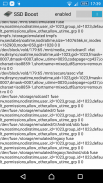




SSD Boost

Deskripsi SSD Boost
**IT NEEDS ROOT**
This is a work in progress project which has the goal to speed performance and extend endurance of smartphone internal flash memory.
Smartphone internal storage uses solid state technology SSD/emmc. Counterpart to lower access time, and less latency of SSD is that its performance may degrade over time: writing after writing, the memory cells show a measurable drop in performance, and will continue degrading throughout the life.
'SSD Boost' minimizes writings on your SSD, increasing speed and extending life of your storage: your smartphone will thank you.
Though the main goal of the app is the optimization of flash memory, many users have also experienced (read the reviews) a better responsiveness in the startup of the apps, a longer battery endurance and a decreased temperature of the phone.
Probably because 'SSD Boost' app is a workaround to some insane process running in the background, that keeps writing to disc. This has been experienced from Android ICS version to Pie (both stock and custom).
It needs a rooted phone.
Be careful, if you have got one of the following models:
- Samsung Galaxy R.
- Samsung Galaxy SII.
- Samsung Galaxy Note.
- Samsung Galaxy Nexus.
- Samsung Epic 4G Touch.
before installing, check presence of Brickbug (a bug on eMMC chip fw): https://play.google.com/store/apps/details?id=net.vinagre.android.emmc_check
Changelog:
1.0.7
- improved root check method
1.0.2
- added TRIM command
What does TRIM for ssd/nand performance.
Unlike HDD, SSD cannot overwrite data because only a transition from 0 to 1 is possible, so before overwriting the data has to erase the whole page to 0 then program the bits.
Erasing takes longer then writing data, so after you used the device for a while it will have to erase the pages before writing them and cripple performance.
It would be so much better if controller would erase the blocks while idle so you have them ready when you need to write. Unfortunately this is not possible as controller has no knowledge of file system so it does not know what blocks are used and with are not.
TRIM command, when supported by the SSD/NAND, allows operating system to send a list of blocks to controller to erase when is idle.
Android 4.3+ supports trim natively, it means that operating system after deleting a file will sends a trim command to nand controller notifying witch blocks the file used, the controller will erase them when idle so it can write fast without erasing next time.
But users have no control over this process and Android doesn't trim the storage for a very long time.
'SSD Boost' helps you to run trim on your device manually if you feel it has become laggy and anyway it does trim for you on every reboot.
It overtakes LagFix (fstrim) limitation, supporting Android 5 Lollipop.
1.0.1
- added NOATIME, NOADIRATIME support
Android maintains file system metadata that records when each file was last accessed. This timestamp is known as atime and atime comes with a performance penalty – every read operation on a filesystem generates a write operation.
Updating the atime every time a file is read causes a lot of usually-unnecessary IO, slowing everything down.
'SSD Boost' disables the tracking of atime, remounting filesystems with the noatime/noadiratime options.
Note:
Some users criticize the name of the app, 'SSD Boost'.
Actually, the word 'boost' is misleading: the app, strictly speaking, doesn't speed up transfer rate, but works around limitations on ssd technology and linux kernel.
Instead, concerning the use of word 'SSD': the most common use is 'flash memory', but when a flash memory implements an interface to some bus, this device constitutes a drive in itself, then it can be properly called SSD.
Every flash memory in every smartphone implements an interface to a bus, so you can use both words mutually.
** INI MEMBUTUHKAN ROOT **
Ini adalah proyek dalam proses yang bertujuan untuk mempercepat kinerja dan memperpanjang daya tahan memori flash internal smartphone.
Penyimpanan internal smartphone menggunakan teknologi solid state SSD / emmc. Yang berlawanan dengan waktu akses yang lebih rendah, dan lebih sedikit latensi SSD adalah kinerjanya dapat menurun seiring waktu: menulis setelah menulis, sel-sel memori menunjukkan penurunan kinerja yang terukur, dan akan terus merosot sepanjang hidup.
'SSD Boost' meminimalkan tulisan pada SSD Anda, meningkatkan kecepatan dan memperpanjang usia penyimpanan Anda: ponsel cerdas Anda akan berterima kasih.
Meskipun tujuan utama dari aplikasi ini adalah optimalisasi memori flash, banyak pengguna juga telah mengalami (baca ulasan) respons yang lebih baik dalam startup aplikasi, daya tahan baterai yang lebih lama dan penurunan suhu ponsel.
Mungkin karena aplikasi 'SSD Boost' adalah solusi untuk beberapa proses gila yang berjalan di latar belakang, yang terus menulis ke disk. Ini telah dialami dari versi Android ICS ke Pie (stok dan custom).
Perlu telepon yang di-rooting.
Hati-hati, jika Anda sudah mendapatkan salah satu model berikut:
- Samsung Galaxy R.
- Samsung Galaxy SII.
- Samsung Galaxy Note.
- Samsung Galaxy Nexus.
- Samsung Epic 4G Touch.
sebelum menginstal, periksa keberadaan Brickbug (bug pada chip eMMC fw): https: //play.google.com/store/apps/details?id=net.vinagre.android.emmc_check
Changelog:
1.0.7
- metode pemeriksaan root yang ditingkatkan
1.0.2
- menambahkan perintah TRIM
Apa yang dilakukan TRIM untuk kinerja ssd / nand.
Tidak seperti HDD, SSD tidak dapat menimpa data karena hanya transisi dari 0 ke 1 yang dimungkinkan, jadi sebelum menimpa data harus menghapus seluruh halaman menjadi 0 lalu memprogram bit.
Menghapus memakan waktu lebih lama daripada menulis data, jadi setelah Anda menggunakan perangkat untuk sementara waktu itu harus menghapus halaman sebelum menulisnya dan melumpuhkan kinerja.
Akan jauh lebih baik jika controller akan menghapus blok saat idle sehingga Anda sudah siap ketika Anda perlu menulis. Sayangnya ini tidak mungkin karena pengontrol tidak memiliki pengetahuan tentang sistem file sehingga tidak tahu blok apa yang digunakan dan tidak.
Perintah TRIM, ketika didukung oleh SSD / NAND, memungkinkan sistem operasi untuk mengirim daftar blokir ke pengontrol untuk dihapus ketika sedang menganggur.
Android 4.3+ mendukung trim secara asli, itu berarti sistem operasi setelah menghapus file akan mengirimkan perintah trim ke nand controller yang memberitahukan penyihir memblokir file yang digunakan, controller akan menghapusnya saat idle sehingga dapat menulis cepat tanpa menghapus waktu berikutnya.
Tetapi pengguna tidak memiliki kontrol atas proses ini dan Android tidak memangkas penyimpanan untuk waktu yang sangat lama.
'SSD Boost' membantu Anda menjalankan trim pada perangkat Anda secara manual jika Anda merasa telah menjadi lamban dan lagi pula itu trim untuk Anda pada setiap reboot.
Ini menyusul pembatasan LagFix (fstrim), mendukung Android 5 Lollipop.
1.0.1
- menambahkan NOATIME, dukungan NOADIRATIME
Android memelihara metadata sistem file yang mencatat kapan setiap file terakhir diakses. Stempel waktu ini dikenal sebagai atime dan atime hadir dengan penalti kinerja - setiap operasi baca pada sistem file menghasilkan operasi tulis.
Memperbarui atime setiap kali file dibaca menyebabkan banyak IO yang biasanya tidak perlu, memperlambat semuanya.
'SSD Boost' menonaktifkan pelacakan atime, remount sistem file dengan opsi noatime / noadiratime.
catatan:
Beberapa pengguna mengkritik nama aplikasi, 'SSD Boost'.
Sebenarnya, kata 'boost' menyesatkan: aplikasi, secara tegas, tidak mempercepat kecepatan transfer, tetapi bekerja di sekitar keterbatasan pada teknologi SSD dan kernel linux.
Alih-alih, mengenai penggunaan kata 'SSD': penggunaan yang paling umum adalah 'memori flash', tetapi ketika memori flash mengimplementasikan antarmuka ke beberapa bus, perangkat ini merupakan drive itu sendiri, maka dapat disebut dengan benar SSD.
Setiap memori flash di setiap ponsel cerdas mengimplementasikan antarmuka ke bus, sehingga Anda dapat menggunakan kedua kata tersebut secara bersama.




























